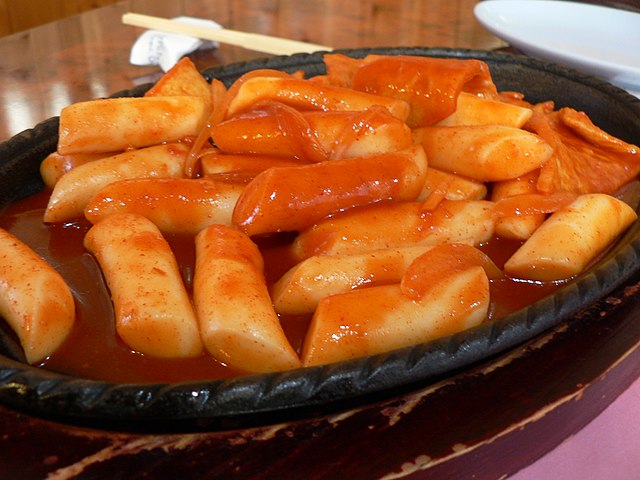Tteokbokki (떡볶이) is one of Korea’s most beloved and iconic street foods. It’s a hugely popular dish featuring cylindrical rice cakes cooked in a vibrant, often fiery red, sweet, and savory sauce.
Here’s a deep dive into Tteokbokki:
What is Tteokbokki?
At its core, Tteokbokki consists of:
- Tteok (떡 – Rice Cakes): These are the star of the show. They are typically long, white, and cylindrical, made from non-glutinous rice flour, and have a wonderfully chewy, slightly springy texture.
- Sauce: This is where the magic happens. The sauce is usually a robust combination of:
- Gochujang (고추장): Korean chili paste, which provides a deep, fermented savory-sweet-spicy base.
- Gochugaru (고춧가루): Korean chili flakes, for extra heat and a beautiful red color.
- Sugar or Corn Syrup: To balance the heat with sweetness.
- Soy Sauce: For added umami and saltiness.
- Garlic and sometimes Onion: For aromatic depth.
- Dashima-Yuksu (kelp broth) or Anchovy Broth (or plain water): To form the liquid base.
Key Characteristics
- Chewy Texture: The unique texture of the rice cakes is a signature characteristic that many find incredibly satisfying.
- Spicy & Sweet Flavor: It strikes a harmonious balance between a delightful sweetness and a building heat, often with a rich umami undertone.
- Vibrant Red Color: Visually appealing and indicative of its spicy nature.
- Versatile: While the basic ingredients are consistent, Tteokbokki is highly adaptable to various additional ingredients.
Common Add-ins & Variations
While plain Tteokbokki is delicious, it’s often enhanced with various additions:
- Eomuk (어묵 – Fish Cakes): Thin, flat sheets or skewers of fish cake are a classic and almost mandatory addition, providing a different texture and savory depth.
- Boiled Eggs (계란): Often served halved, the yolk can be mashed into the sauce.
- Ramyeon or Jjolmyeon (라면/쫄면): Instant ramen noodles or chewy wheat noodles added to the dish (creating “Rabokki” 라볶이).
- Cheese (치즈): Melted mozzarella or other cheeses, especially popular with younger generations, which adds creaminess and mellows the spice.
- Mandu (만두 – Dumplings): Fried or steamed dumplings.
- Sausage/Hot Dogs: Sliced into rounds.
- Vegetables: Cabbage, scallions, onions, carrots are often included for freshness and texture.
- Seafood: Shrimp, mussels, or squid can be added, particularly in coastal regions.
Beyond the classic red sauce
- Jjajang Tteokbokki (짜장 떡볶이): Made with Korean black bean paste (jjajang) instead of gochujang, resulting in a savory, slightly sweet, and non-spicy dark brown sauce.
- Gungjung Tteokbokki (궁중 떡볶이): “Royal Court Tteokbokki” is a traditional, non-spicy version made with soy sauce, beef, and various vegetables, tracing back to the Joseon Dynasty.
- Cream Tteokbokki: A modern fusion take with a creamy, usually non-spicy, white sauce.
Cultural Significance & Popularity
- Street Food Staple: Tteokbokki is an omnipresent fixture in Korea, found everywhere from street stalls (pojangmacha) to snack bars (bunsikjip) and restaurants.
- Comfort Food: It evokes a sense of nostalgia and comfort for many Koreans, often associated with childhood memories and quick, satisfying meals with friends.
- Snack & Meal: It can be enjoyed as a quick snack, a light lunch, or a hearty meal, especially when combined with other ingredients like ramen or fish cakes.
- Global Recognition: With the rise of Hallyu (Korean Wave), Tteokbokki has gained immense popularity worldwide, becoming a recognizable symbol of Korean cuisine.
How to Enjoy It
Tteokbokki is best eaten hot and fresh. It’s often served in a large pan or plate, sometimes with a ladle, and people pick out pieces with toothpicks or chopsticks. It’s common to order it with other street food items like Sundae (순대 – Korean blood sausage), Kimbap (김밥 – seaweed rice rolls), or 튀김 (Twuikim – various fried items like tempura), dipping them into the leftover Tteokbokki sauce.
Brief History
While the modern red, spicy Tteokbokki gained prominence after the Korean War (when gochujang became more accessible and a thicker, more flavorful sauce emerged), rice cakes themselves have a long history in Korean cuisine. The aforementioned “Gungjung Tteokbokki” is an older, soy-sauce-based version. The famous “Tteokbokki Town” in Sindang-dong, Seoul, is often credited as a hub where the dish evolved into the beloved spicy form we know today.
In summary, Tteokbokki is more than just a dish; it’s a culinary experience – a delightful interplay of textures and flavors that captivates anyone who tries it.
